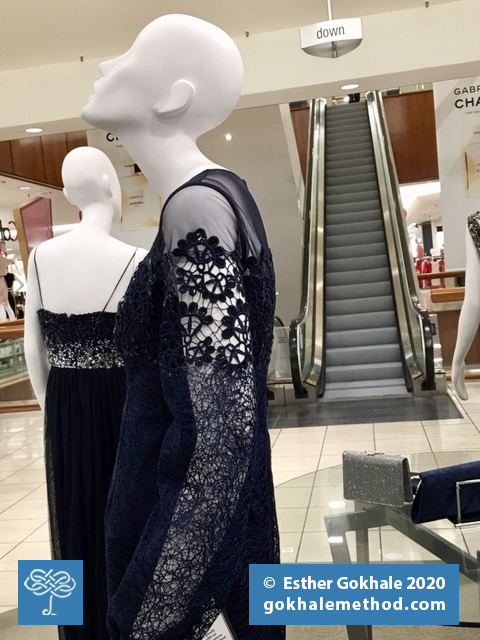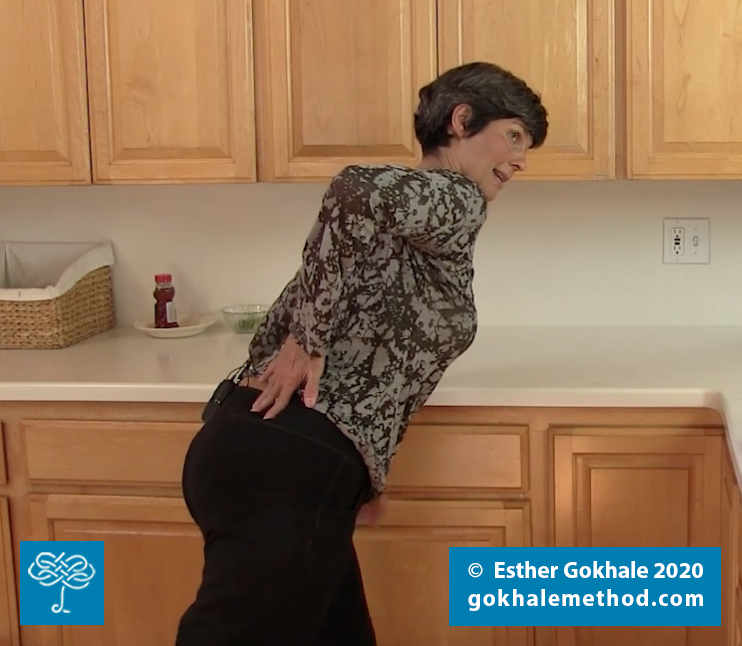How (and Why) to Keep Your Neck Tall
My Favorite Exercises for When You Can’t Get to the Gym, Part 2: Toning the Gluteus Medius
Cultivating a J-Spine with Chair Pose (Utkatasana)
As a student and teacher of yoga and practitioner of the Gokhale Method, I choose yoga poses that make good use of my time. “Chair pose” is well worth the time investment. In fact, it has become one of my favorite strength-building postures. It is useful for cultivating a J-shaped spine. It helps increase gluteal tone. It helps to pattern healthy hip movement. It is strengthening for the legs and spinal stabilizers. And, last but not least, it allows a yoga practitioner to smoothly transition between a standing forward fold and mountain pose — without compression of the intervertebral discs.
Cecily Frederick in chair pose with J-spine visible, overlaid with SpineTracker™ snapshot.
Detail of
Opening Your Heart Space
This bronze figure shows an open chest and “heart space;” his shoulders are well back and his ribcage is anchored. He is part of a fountain in Piccadilly Circus, London, sculpted by Sir Alfred Gilbert in 1893. Referred to (erroneously) as “Eros,” the figure is in fact Anteros, Eros’ brother, who represents a more mature, less capricious love. Original image courtesy Gareth Williams under CC BY 2.0.
“Heart space” is a term used in yoga to describe the upper part of the chest where the heart is located. Valentine’s Day is an ideal time to give some special attention to this region, and explore its relation to your posture and wellbeing.
The Gokhale Method teaches four particular techniques
When Is It Good to Pull Back Your Shoulders?
This is the second post in our series on shoulder positioning. Read Part 1 here!
Typing with shoulders too far forward.
Often, in industrialized cultures, the shoulders are slumped or held forward. There are so many daily tasks in the modern world that make it all too easy for these bad habits to set in: holding our arms out front for hours with poor shoulder placement while we are typing, gaming, driving, and so on. Over the years this is likely to cause various problems:
Impingement, bursitis, wear-and-tear
Reduced circulation to the arms
Compromised breathing patterns
Reduced athletic performance, increased injuries
Hunched upper back and forward head
Common pitfalls in getting the shoulders
Your Most Striking Posture Feature: Shoulder Position
The arm and shoulder of this African carpenter align with the back of his torso.
One of the most striking features of good posture is the position of the shoulders. The posture of this African carpenter shows how, with the shoulders well back, the arms align more with the back of the body than the front. The side of the chest and ribcage are clearly visible. Positioning the shoulders well brings you many benefits. It aligns your shoulder joint correctly, avoiding impingement, bursitis, arthritis, tendinitis, and general wear and tear. It improves circulation to your arms, as well as your breathing pattern. Optimal shoulder positioning improves athletic performance: throwing, punching, and
How to Sit on the Floor, Part 3: Sitting with Legs Outstretched
This is the third post in our multi-part series on floor-sitting. Read Part 1 on floor sitting and Part 2 on squatting!
It’s very common for women in Africa to sit with their legs outstretched. I’ve seen rows of women use this position to spin yarn, engage in idle chatter, sort items, and more. I’ve seen babies massaged by women using this position both in Burkina Faso and in the U.S. by a visiting Indian masseuse who does traditional baby massage in Surat, India. In Samiland I saw this position used to bake bread in a lavoo (a Sami structure very similar to a teepee).
The Sami, who I visited in July 2015 (see my post Sleeping on Birch Branches in Samiland), bake with outstretched legs in
Glidewalking: Sitting’s Long-Lost Counterpart
Mother and son in a tribal Orissan village demonstrating excellent walking form. Notice that their heels remain on the floor well into their stride.
Do you have tight psoas muscles? Do you suspect the cause is too much time spent sitting in your daily life? There’s a complementary activity that helps counterbalance the time we spend sitting: walking — or, more specifically, glidewalking. Glidewalking helps balance our sitting in numerous ways — walking is dynamic versus sitting which is static. Yang balances Yin, viewed in the framework of traditional Chinese medicine. One underappreciated way in which walking can balance sitting pertains to the psoas muscle.
The psoas muscle originates on


